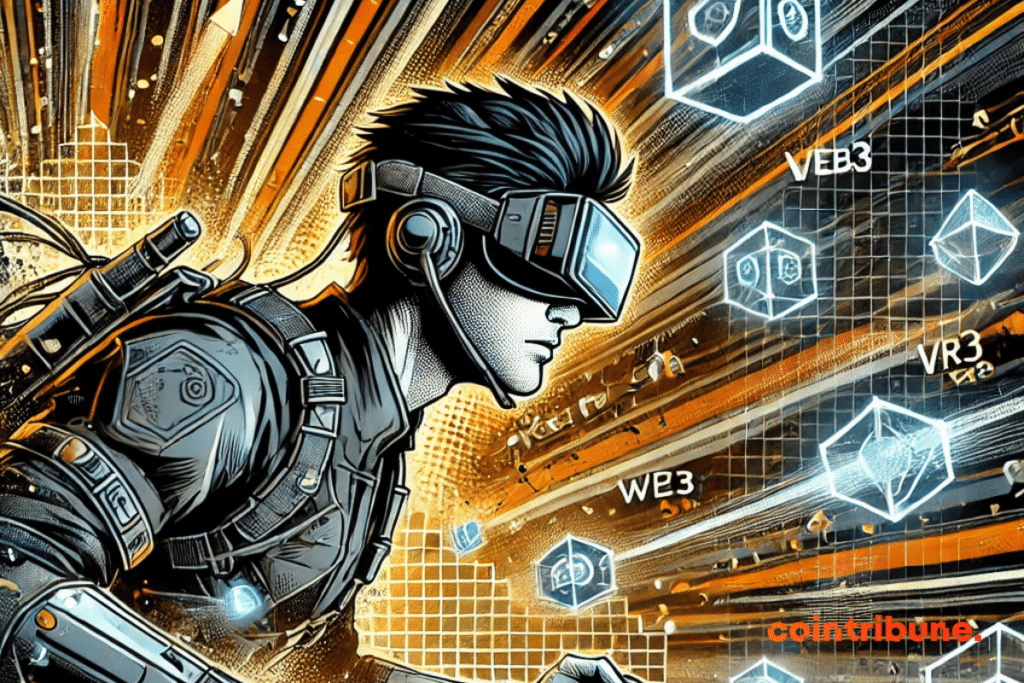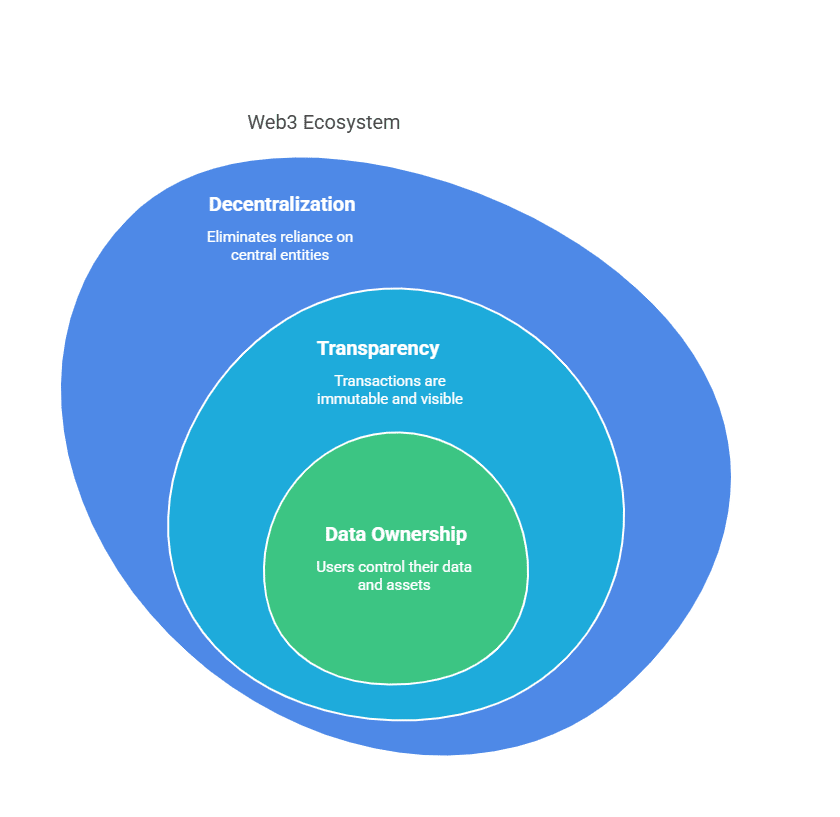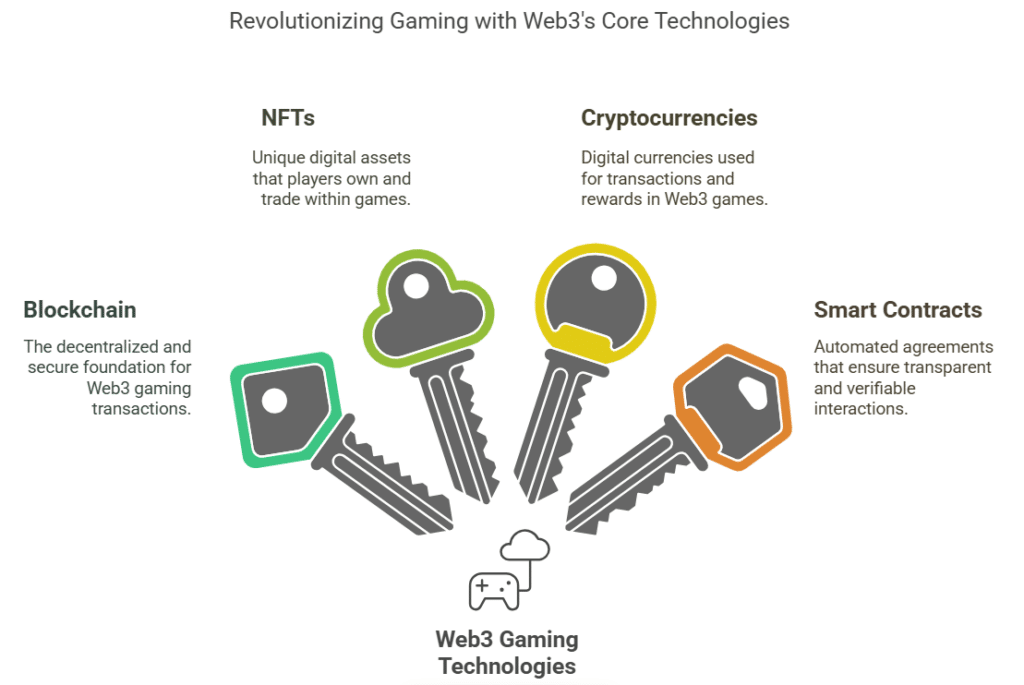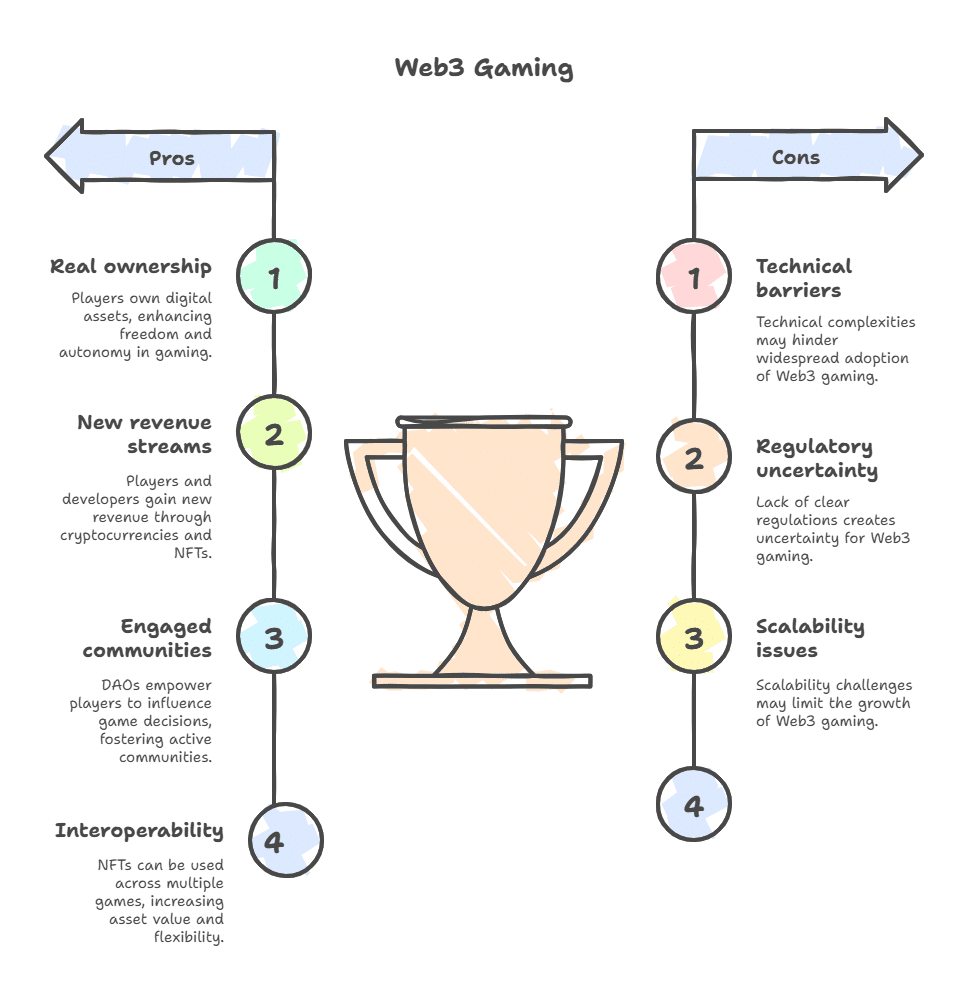What Is Web3 Gaming?
The Web3 marks a new era of the internet based on blockchain. It relies on decentralization, transparency, and digital ownership. This evolution impacts several sectors, including the video game industry. Web3 gaming introduces new mechanisms, such as real ownership of digital assets and integrated in-game economies. This approach transforms the relationship between players and developers. Players are no longer just consumers of content; they actively participate in the ecosystem. This article explores the foundations of Web3 gaming, its key technologies, its economic models, and its challenges. It also presents the opportunities, challenges, and future prospects for this rapidly evolving sector.

In Brief
- Definition: Web3 gaming refers to a new generation of video games that integrate blockchain, NFTs, and cryptocurrencies to offer real ownership of digital assets.
- Key technologies: blockchain, NFTs, cryptocurrencies, and smart contracts ensure decentralization, security, interoperability, and traceability in games.
- Economic models: Play-to-Earn, Play-and-Earn, and Free-to-Own enable players to generate income while participating in the game’s economy.
- Benefits: ownership of assets, new sources of income, involvement through DAOs, and interoperability between games.
- Challenges: scalability of blockchains, complexities for newcomers, security risks, and excessive speculation.
- Notable examples: Axie Infinity, Illuvium, and Sorare illustrate current uses of Web3 in gaming.
- Perspectives: towards broader adoption with improved infrastructure, better UX, and integration into the metaverse.
Understanding Web3
Web3 represents a major evolution of the internet. It is based on principles of decentralization and transparency. Unlike traditional models, it gives users control over their data and digital assets.
The definition of Web3
Web3 refers to a new generation of the internet based on blockchain. It does not rely on central entities like large Web2 platforms. Thanks to decentralized technologies, it allows users to interact directly with each other without intermediaries.
This approach promotes digital sovereignty. Data is no longer stored on centralized servers, but distributed across a secure network. Each user holds their own information and can prove its authenticity through blockchain.
The fundamental principles of Web3

Web3 rests on three essential pillars:
- Decentralization;
- Transparency;
- Data ownership.
First, decentralization eliminates dependence on large corporations. Applications operate on distributed networks, making the ecosystem more resilient to censorship. Next, transparency ensures the integrity of transactions. Blockchains record each operation immutably. Everyone can consult this data without any possibility of alteration.
Finally, data ownership gives users total control. Unlike Web2, where platforms exploit personal information, Web3 secures this data in personal digital wallets.
The major differences between Web2 and Web3
Web2 relies on centralized services. Companies collect and monetize users’ data. Transactions require trust in third parties.
Web3, on the other hand, operates without intermediaries. Blockchain ensures the security of exchanges. Users own their digital assets and manage their interactions without a central authority. This transition transforms the way the internet is used.
The key technologies of Web3 gaming
Web3 gaming relies on technological innovations that revolutionize the video game industry. These technologies ensure decentralization, security, and transparency of interactions. They allow players to own and exchange their digital assets without intermediaries.

The blockchain
Blockchain is the technological foundation of Web3 gaming. It stores data in a decentralized and secure manner. Each transaction is recorded in an immutable ledger, accessible to all participants in the network.
In a Web3 game, the blockchain ensures transparency of exchanges and traceability of digital assets. Players can buy, sell, or exchange items without going through a central entity. This approach enhances trust and reduces the risks of fraud.
NFTs (Non-Fungible Tokens)
NFTs represent unique items in a game. Unlike traditional assets, they have their own identity and cannot be copied or replaced. Developers use this technology to create characters, equipment, land, or rare items.
Players actually own their NFTs. They can resell, lend, or use them in other compatible games. This flexibility promotes interoperability and adds an economic dimension to gaming experiences.
Cryptocurrencies
Cryptocurrencies play a central role in Web3 gaming. They serve as a means of exchange and reward for players. Unlike virtual currencies of traditional games, they have real value and can be used outside the game.
Players earn cryptocurrencies by completing missions, selling items, or participating in the game’s economy. Some platforms even allow converting these gains into fiat currency, creating new income opportunities.
Smart contracts
Smart contracts automate transactions and interactions in Web3 games. They operate as programs stored on the blockchain and their execution requires no human intervention.
In a game, a smart contract can manage the sale of an item, the payment of a reward, or the organization of a tournament. Its functioning is transparent and verifiable by all players. It ensures the enforcement of rules without the risk of manipulation.
These technologies transform the gaming industry by providing more control to players. They make experiences more immersive and pave the way for new economic models.
The economic models of Web3 gaming
Web3 gaming introduces new economic models. Unlike traditional games, these models allow players to gain real value for their time and efforts. Some games offer rewards in the form of cryptocurrencies or NFTs, while others prioritize a balance between entertainment and profitability.
Play-to-Earn (P2E)
The Play-to-Earn model is based on rewarding players with cryptocurrencies or NFTs. They can complete quests, battle opponents, or trade items to earn redeemable rewards. This system attracts a large community, especially in countries where economic opportunities are limited.
Games like Axie Infinity have popularized this model. Players breed, train, and battle creatures called Axies. By winning battles, they receive tokens that can be exchanged for real money. However, some P2E games require an initial investment to purchase NFTs, limiting accessibility to all players.
Play-and-Earn
The Play-and-Earn model emphasizes the enjoyment of gameplay while offering potential rewards. Unlike P2E, the main goal remains the gaming experience. Players are not required to invest to participate but can earn rewards if they engage with the game.
Titles like Gods Unchained illustrate this approach. This strategic card game allows players to earn NFTs by playing and winning matches. These cards have value on the secondary market, but acquiring them is a bonus and not a necessity for progression. This model attracts a broader audience by reducing the pressure associated with profitability.
Free-to-Own
The Free-to-Own model allows players to access games for free while having the option to own digital assets. Unlike traditional games where players purchase skins or items without real value, this model guarantees transferable digital ownership.
Guild of Guardians adopts this system. Players obtain NFT heroes by playing, without having to pay. They can then use them to battle or sell them on secondary markets. This model promotes a more equitable distribution of assets and limits excessive speculation.
These economic models profoundly change the video game industry. They provide players with unprecedented financial opportunities, but raise challenges such as the sustainability of virtual economies. Developers must balance earnings and the gaming experience to ensure the long-term success of Web3 games.
The advantages and opportunities of Web3 gaming
Web3 gaming transforms the video game industry by offering new possibilities to players and developers. It allows for better monetization of digital assets and more active community involvement.

Real ownership of digital assets for players
Players truly own their digital items thanks to blockchain technology. Unlike traditional games where assets remain under the control of publishers, Web3 guarantees full ownership. Every item acquired, whether it be a character, equipment, or land, belongs to the player and remains usable outside of the game.
This evolution enhances user freedom. They can retain their assets, trade them, or sell them without relying on a company. This approach fosters greater autonomy and reduces risks of loss in case of a game’s closure.
New sources of revenue for players and developers
Web3 gaming introduces unprecedented economic opportunities. Players can earn cryptocurrencies or NFTs while playing and then convert them into real money. This model offers an alternative to traditional economic systems based on purchasing digital content without tangible value.
Developers also benefit from new revenue streams. Thanks to NFTs and smart contracts, they earn commissions on each transaction between players. This model encourages a more dynamic economy and incentivizes the creation of scalable games.
Creating more engaged communities through DAOs
Decentralized Autonomous Organizations (DAOs) allow players to influence decisions in Web3 games. They can vote on rule changes, development of new content, or allocation of rewards.
This approach enhances player involvement and creates more active communities. Games become collaborative ecosystems where everyone can contribute to their success.
The ability to transfer assets between different games and platforms
Web3 gaming offers unprecedented interoperability. Players can use their NFTs in multiple compatible games. This flexibility increases the value of assets and opens up new perspectives for connected universes.
This approach fosters the creation of an ecosystem where digital objects are not limited to a single experience. It encourages developers to build interconnected games and enrich opportunities for players.
Challenges and criticisms facing Web3 gaming
Web3 gaming brings innovations, but it also raises technical and economic challenges. Some obstacles hinder its adoption and provoke criticism within the video game industry.

Scalability and performance issues of current blockchains
Blockchains handle a limited number of transactions per second. This limit slows interactions in Web3 games and incurs high fees during peak activity. Some networks like Ethereum face congestion, making transactions costly and slow.
Solutions like sidechains and rollups attempt to improve scalability. Despite these advances, games still need to optimize their infrastructures to ensure a smooth and lag-free experience.
The complexity of use for players unfamiliar with blockchain
The access to Web3 games is more complex than that of traditional games. Players must create a crypto wallet, understand transactions in cryptocurrencies, and secure their private keys. This complexity hinders widespread adoption.
Developers are looking to simplify the user experience. Some games integrate built-in wallets and fiat payments to facilitate entry for new players.
Risks related to security and potential scams
Web3 gaming attracts cybercriminals. Vulnerabilities in smart contracts expose players to fund theft and hacks. Some poorly secured platforms disappear after collecting investments, leading to significant financial losses.
Players must verify the reliability of projects before investing. Security audits and developer transparency play a key role in protecting users.
Criticism regarding excessive speculation around NFTs and cryptocurrencies
Some Web3 games encourage speculation rather than the gaming experience. Investors buy NFTs hoping for a more expensive resale, leading to a financial bubble. When demand decreases, asset values drop and players lose their investment.
Some critics argue that these games prioritize profitability over gameplay. To ensure their success, developers must balance economic mechanisms and offer real gaming value to players.
Notable examples of Web3 games
Some Web3 games stand out due to their popularity and massive adoption. They integrate technologies like blockchain and NFTs, transforming the experience of players and the economic model of video games.
Axie Infinity
Axie Infinity is based on collecting and battling creatures called Axies. Each Axie is an NFT that players can buy, sell, or breed. The game uses the Ethereum blockchain and allows players to earn cryptocurrencies by facing opponents. Its Play-to-Earn model has attracted thousands of users, but the collapse of its economy has revealed limits related to speculation and long-term profitability.
Illuvium
Illuvium combines an open-world role-playing game and an auto-battler. Players capture creatures called Illuvials, represented as NFTs. This game leverages the possibilities of Web3 to offer an immersive universe and an interoperable ecosystem. Its more sophisticated gameplay and better-structured economic system attract strategy and collection enthusiasts.
Sorare
Sorare revolutionizes fantasy football by using player cards in the form of NFTs. Each digital card has a unique value and can be traded on a secondary market. Players assemble their teams and participate in competitions to win rewards. This model attracts football enthusiasts and investors.
These games have demonstrated the potential of Web3 gaming. They highlight the interest in NFTs and cryptocurrencies in the gaming industry. However, their success depends on balancing gameplay, profitability, and adoption by the general public.
What is the future of Web3 gaming?
Web3 gaming continues to evolve and could significantly transform the video game industry. Its adoption will depend on technological innovations and accessibility to the general public.
Web3 games will become more sophisticated thanks to advancements in scalability and interoperability. Developers will seek to enhance the user experience to attract new players. Major video game companies will gradually integrate Web3 elements. The arrival of hybrid solutions will facilitate the transition between traditional games and blockchain.
Web3 gaming will play a key role in building the metaverse. Digital assets will circulate between several universes, offering immersive and connected experiences.
Web3 gaming relies on blockchain, NFTs, and cryptocurrencies. It introduces new economic models and redefines the ownership of digital assets. Players gain autonomy, while developers explore unprecedented opportunities. This revolution transforms the video game industry. It promotes more open economies and more immersive interactive experiences. However, challenges remain, particularly concerning scalability and regulation. The adoption of Web3 in games will depend on its accessibility and gradual integration. Future developments will determine its impact on the market. Staying informed is essential to understand this transformation.
FAQ
Some games offer Free-to-Play access, but purchasing and trading digital assets often requires a wallet and cryptocurrencies. Solutions like Flow simplify these interactions for new players.
Currently, most Web3 games are available on PC and mobile, but some companies are exploring console integration. Compatibility depends on manufacturers’ policies toward crypto and blockchain technology.
Yes, some Web3 games adopt a Free-to-Play or Free-to-Own model, allowing players to access content without an initial purchase. However, economic rewards may be limited without active participation in the game’s ecosystem.
Maximize your Cointribune experience with our "Read to Earn" program! For every article you read, earn points and access exclusive rewards. Sign up now and start earning benefits.
Diplômé de Sciences Po Toulouse et titulaire d'une certification consultant blockchain délivrée par Alyra, j'ai rejoint l'aventure Cointribune en 2019. Convaincu du potentiel de la blockchain pour transformer de nombreux secteurs de l'économie, j'ai pris l'engagement de sensibiliser et d'informer le grand public sur cet écosystème en constante évolution. Mon objectif est de permettre à chacun de mieux comprendre la blockchain et de saisir les opportunités qu'elle offre. Je m'efforce chaque jour de fournir une analyse objective de l'actualité, de décrypter les tendances du marché, de relayer les dernières innovations technologiques et de mettre en perspective les enjeux économiques et sociétaux de cette révolution en marche.
The views, thoughts, and opinions expressed in this article belong solely to the author, and should not be taken as investment advice. Do your own research before taking any investment decisions.